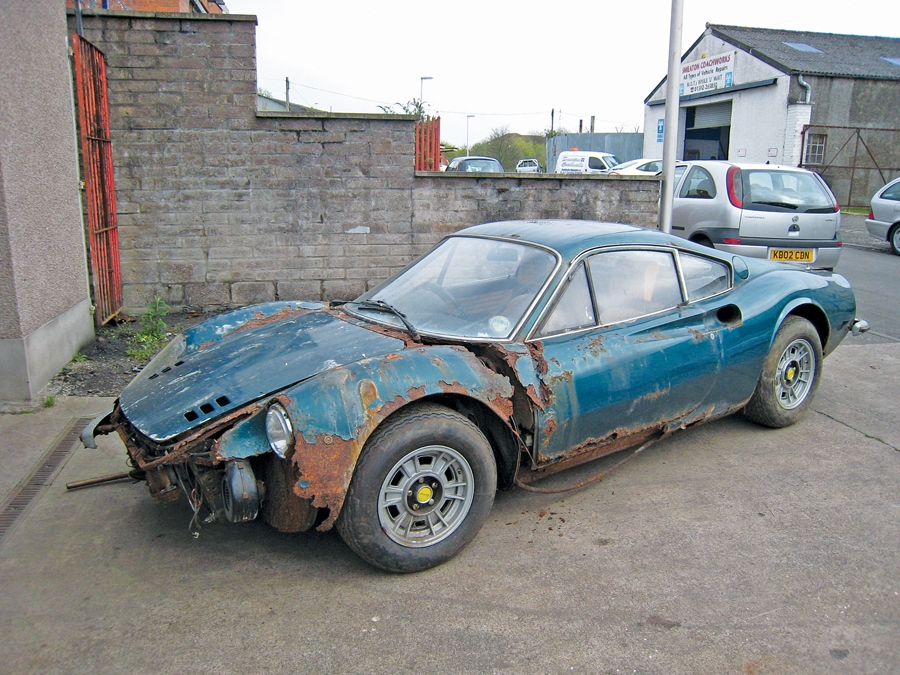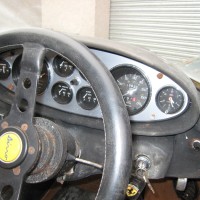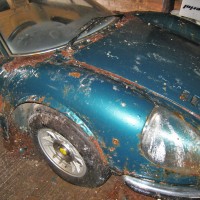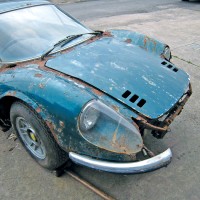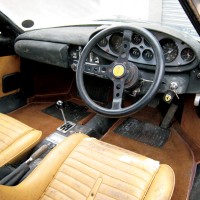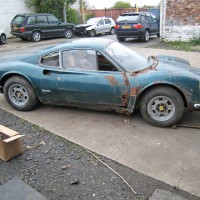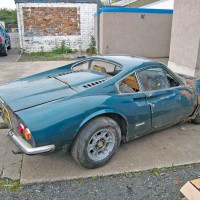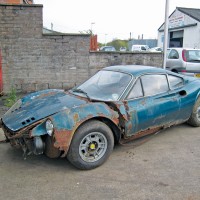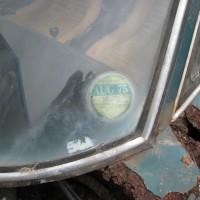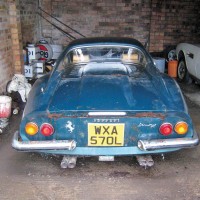SCM Analysis
Detailing
| Vehicle: | 1973 Ferrari 246 GT Dino Barn Find |
| Number Produced: | 246 GT, 2,609; 246 GTS, 1,274 |
| Original List Price: | 246 GTS, $15,225 (1974) |
| Tune Up Cost: | $3,500 |
| Distributor Caps: | $350 |
| Engine Number Location: | Side of block before oil filter |
| Club Info: | Ferrari Club of America |
| Website: | http://www.FerrariClubofAmerica.org |
| Investment Grade: | B |
This car, Lot 316, sold for $222,718 including buyer’s premium, at Silverstone Auctions’ sale in Northamptonshire, U.K., on May 24, 2014.
Silverstone Auctions set out their shingle in 2011, which makes them a newcomer to the vintage-car auction scene. Their claim to fame is being the official auctioneer for the Silverstone motor-racing circuit. They specialize in collector cars, but they also sell automobilia, motorcycles, watches — and dabble in aviation items. Among the offerings at this sale was a fully restored Dino 246 GT. That car brought around $430,000. The differential between it and the barn find was roughly $200,000. Could that be enough to make 05596 a good buy?
Years ago, a Dino was dragged out of the Florida Keys, where the salt air had savaged the body and the sun had baked anything left to well done. This was back before Dinos were valuable, and the mechanicals went to a Lancia Stratos collector in Georgia, while the balance just went to the crusher. That car was a hot mess, but it may have been in better condition than 05596.
A horrible hulk
Examining pictures of 05596, it looks to be a pretty wretched hulk. There’s severe rust damage to the body, and the undercarriage appears to have suffered the same fate. Every plated or painted surface in the engine compartment has surface corrosion. There is glass missing from at least two windows. The interior does not show obvious damage, but the missing windows would have allowed the moisture that devoured the rest of the car to breed mold throughout the interior.
The engine and transaxle have probably survived with less damage than the body. However, I can’t imagine a scenario where every part doesn’t have to be disassembled, cleaned, refinished and reassembled. This won’t stop with the major components — it will continue down to the small assemblies like the cooling and heating fan motors. Ferrari restorations are usually done without removing the body from the frame, but I don’t see restoring this gem without stripping it to its core.
Start your checkbook!
Restoring a Dino is not as easy as restoring an old 250 Ferrari. The main reason is that the modern cars have more content. They have features such as electric windows and air conditioning, all of which have switches, motors and related components that can require attention. These items are manufactured rather than fabricated and are difficult to replicate.
A window-lift assembly for a 250 was fabricated in small quantities — often by hand. They were made on low-tech equipment and can be duplicated in a good restoration shop. On the other hand, an air conditioning system is made of many mass-produced parts that are often built on high-tech machinery. A restoration shop can’t build an a/c compressor from scratch.
The goal of a proper restoration is to return the car to as close to its original condition as possible. There are many benchmark-quality Dinos, so incorrect parts — or even incorrectly restored parts — quickly stand out when compared with an original. A couple of incorrect items are acceptable, but too many errors put the car in a different class.
Chassis 05596 can be restored. Dino specialists Superformance in the U.K. offer everything from frame tubes to body skin to interior trim, so the parts are available. Many of the parts may be pattern — a British term for aftermarket — and not necessarily exactly like original, but I suspect the new owner won’t be going for concours level.
The front clip alone will run close to $20,000. The cost of other needed parts might top that number. Labor is impossible to estimate, but it will be an especially laborious job. Just sourcing parts will take tens of hours spread over months. A friend at a top restoration shop told me he wouldn’t start the job unless there was a $400,000 budget. Using local talent would significantly drop the number, but it will still take over $100,000 to put 05596 back on the road.
A possible art display
Of course, the new owner may have something else in mind for the Dino. He could be considering exhibiting it just as it sits — like the Type 22 Bugatti that lived over 70 years on the bottom of Lake Maggiore on the border of Italy and Switzerland. The Bugatti has been preserved as it was found, and it now resides in the Mullin Automotive Museum in California.
Another trashed Ferrari recently made headlines after selling at an art auction. French artist Bertrand Lavier is known for turning found objects into art. In 1993, he took a horribly wrecked Ferrari 308 GT4 that might have brought $10,000 as a parts car and mounted it on a $1,000 plywood base. Lavier later became an art-world darling, and everything he touched turned to gold. A wealthy Turkish collector became enamored with the Ferrari piece and coughed up $250,000 to take it home from a Paris exhibit this spring.
Another barn find?
Silverstone did a great job of working the barn-find angle. The catalog pictures showed the obligatory shots of the car in and in front of its tomb. The write-up spun the tale of why the car was neglected for all the years. They got every pound that the car was worth. The seller should be thrilled with the result.
On paper, the buyer looks potentially okay. With luck, the car can be restored and resold for a profit. But it will be a huge project. Based on today’s market, the return will hardly be worth the risk. The buyer is probably betting that the market will have advanced before the project is finished. I’m betting that 25 years from now, a garage will be unsealed to find an unfinished Dino project bearing chassis number 05596. ♦
(Introductory descriptions courtesy of Silverstone Auctions.)
